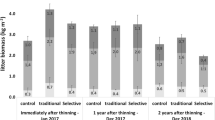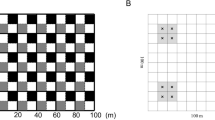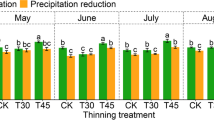Abstract
Microbial functional diversity and enzymatic activities are critical to maintaining material circulation during litter decomposition in forests. Thinning, an important and widely used silvicultural treatment, changes the microclimate and promotes forest renewal. However, how thinning affects microbial functional diversity and enzymatic activities during litter decomposition remains poorly understood. We conducted thinning treatments in a Chinese fir plantation in a subtropical region of China with four levels of tree stem removal (0, 30, 50, and 70%), each with three replicates, and the effects of thinning on microbial functional diversity and enzymatic activities were studied 7 years after treatment by collecting litter samples four times over a 1-year period. Microbial functional diversity and enzymatic activities were analyzed using Biolog Ecoplates (Biolog Inc., Hayward, CA, USA) based on the utilization of 31 carbon substrates. Total microbial abundance during litter decomposition was lower after the thinning treatments than without thinning. Microbial functional diversity did not differ significantly during litter decomposition, but the types of microbial carbon-source utilization did differ significantly with the thinning treatments. Microbial cellulase and invertase activities during litter decomposition were significantly higher under the thinning treatments due to changes in the litter carbon concentration and the ratios of carbon and lignin to nitrogen. The present study demonstrated the important influence of thinning on microbial activities during litter decomposition. Moderate-intensity thinning may maximize vegetation diversity and, in turn, increase the available substrate sources for microbial organisms in litter and promote nutrient cycling in forest ecosystems.





Similar content being viewed by others
References
Aber JD (1992) Nitrogen cycling and nitrogen saturation in temperate forest ecosystems. Trends Ecol Evol 7(7):220–224. https://doi.org/10.1016/0169-5347(92)90048-G
Adamczyk B, Kilpeläinen P, Kitunen V, Smolander A (2014) Potential activities of enzymes involved in N, C, P and S cycling in boreal forest soil under different tree species. Pedobiologia 57(2):97–102. https://doi.org/10.1016/j.pedobi.2013.12.003
Adamczyk B, Adamczyk S, Kukkola M, Tamminen P, Smolander A (2015) Logging residue harvest may decrease enzymatic activity of boreal forest soils. Soil Biol Biochem 82:74–80. https://doi.org/10.1016/j.soilbio.2014.12.017
Alarcón-Gutiérrez E, Floch C, Augur C, Petit JL, Ziarelli F, Criquet S (2009) Spatial variations of chemical composition, microbial functional diversity, and enzyme activities in a Mediterranean litter (Quercus ilex L.) profile. Pedobiologia 52(6):387–399. https://doi.org/10.1016/j.pedobi.2009.01.002
Allison SD, Vitousek PM (2004) Extracellular enzyme activities and carbon chemistry as drivers of tropical plant litter decomposition. Biotropica 36(3):285–296. https://doi.org/10.1111/j.1744-7429.2004.tb00321.x
Andersen R, Chapman SJ, Artz RRE (2013) Microbial communities in natural and disturbed peatlands: a review. Soil Biol Biochem 57:979–994. https://doi.org/10.1016/j.soilbio.2012.10.003
Andersson M, Kjøller A, Struwe S (2004) Microbial enzyme activities in leaf litter, humus and mineral soil layers of European forests. Soil Biol Biochem 36(10):1527–1537. https://doi.org/10.1016/j.soilbio.2004.07.018
Artigas J, Majerholc J, Foulquier A, Margoum C, Volat B, Neyra M, Pesce S (2012) Effects of the fungicide tebuconazole on microbial capacities for litter breakdown in streams. Aquat Toxicol 122–123:197–205. https://doi.org/10.1016/j.aquatox.2012.06.011
Baldrian P, Kolarik M, Stursova M, Kopecky J, Valaskova V, Vetrovsky T, Zifcakova L, Snajdr J, Ridl J, Vlcek C, Voriskova J (2012) Active and total microbial communities in forest soil are largely different and highly stratified during decomposition. ISME J 6(2):248–258. https://doi.org/10.1038/ismej.2011.95
Bardgett RD, Jones AC, Jones DL, Kemmitt SJ, Cook R, Hobbs PJ (2001) Soil microbial community patterns related to the history and intensity of grazing in sub-montane ecosystems. Soil Biol Biochem 33(12–13):1653–1664. https://doi.org/10.1016/S0038-0717(01)00086-4
Bartelt-Ryser J, Joshi J, Schmid B, Brandl H, Balser T (2005) Soil feedbacks of plant diversity on soil microbial communities and subsequent plant growth. Perspect Plant Ecol Evol Syst 7(1):27–49. https://doi.org/10.1016/j.ppees.2004.11.002
Bates D, Bolker B, Walker S, Christensen RHB, Singmann H, Dai B, Grothendieck G (2016) lme4: linear mixed-effects models using Eigen and S4. R package version 1 (1.1 − 12)
Berga M, Szekely AJ, Langenheder S (2012) Effects of disturbance intensity and frequency on bacterial community composition and function. PLoS ONE 7(5):e36959. https://doi.org/10.1371/journal.pone.0036959
Blanco JA, Imbert JB, Castillo FJ (2006) Influence of site characteristics and thinning intensity on litterfall production in two Pinus sylvestris L. forests in the western Pyrenees. For Ecol Manag 237(1–3):342–352. https://doi.org/10.1016/j.foreco.2006.09.057
Boerner R, Giai C, Huang J, Miesel J (2008) Initial effects of fire and mechanical thinning on soil enzyme activity and nitrogen transformations in eight North American forest ecosystems. Soil Biol Biochem 40(12):3076–3085. https://doi.org/10.1016/j.soilbio.2008.09.008
Bolat İ (2013) The effect of thinning on microbial biomass C, N and basal respiration in black pine forest soils in Mudurnu, Turkey. Eur J For Res 133(1):131–139. https://doi.org/10.1007/s10342-013-0752-8
Bowman WD, Steltzer H, Rosenstiel TN, Cleveland CC, Meier CL (2004) Litter effects of two co-occurring alpine species on plant growth, microbial activity and immobilization of nitrogen. Oikos 104:336–344. https://doi.org/10.1111/j.0030-1299.2004.12721.x
Bray SR, Kitajima K, Mack MC (2012) Temporal dynamics of microbial communities on decomposing leaf litter of 10 plant species in relation to decomposition rate. Soil Biol Biochem 49:30–37. https://doi.org/10.1016/j.soilbio.2012.02.009
Bundschuh M, Zubrod JP, Kosol S, Maltby L, Stang C, Duester L, Schulz R (2011) Fungal composition on leaves explains pollutant-mediated indirect effects on amphipod feeding. Aquat Toxicol 104(1–2):32–37. https://doi.org/10.1016/j.aquatox.2011.03.010
Chen XL, Wang D, Chen X, Wang J, Diao JJ, Zhang JY, Guan QW (2015) Soil microbial functional diversity and biomass as affected by different thinning intensities in a Chinese fir plantation. Appl Soil Ecol 92:35–44. https://doi.org/10.1016/j.apsoil.2015.01.018
Chen XL, Chen HYH, Chen X, Wang J, Chen B, Wang D, Guan QW (2016) Soil labile organic carbon and carbon-cycle enzyme activities under different thinning intensities in Chinese fir plantations. Appl Soil Ecol 107:162–169. https://doi.org/10.1016/j.apsoil.2016.05.016
Cleveland CC, Reed SC, Keller AB, Nemergut DR, O’Neill SP, Ostertag R, Vitousek PM (2014) Litter quality versus soil microbial community controls over decomposition: a quantitative analysis. Oecologia 174(1):283–294. https://doi.org/10.1007/s00442-013-2758-9
Cookson WR, O’Donnell AJ, Grant CD, Grierson PF, Murphy DV (2008) Impact of ecosystem management on microbial community level physiological profiles of postmining forest rehabilitation. Microb Ecol 55(2):321–332. https://doi.org/10.1007/s00248-007-9278-2
Creamer CA, de Menezes AB, Krull ES, Sanderman J, Newton-Walters R, Farrell M (2015) Microbial community structure mediates response of soil C decomposition to litter addition and warming. Soil Biol Biochem 80:175–188. https://doi.org/10.1016/j.soilbio.2014.10.008
Deng SP, Tabatabai MA (1994) Cellulase activity of soils. Soil Biol Biochem 26(10):1347–1354. https://doi.org/10.1016/0038-0717(94)90216-X
Dong WY, Zhang XY, Liu XY, Fu XL, Chen FS, Wang HM, Sun XM, Wen XF (2015) Responses of soil microbial communities and enzyme activities to nitrogen and phosphorus additions in Chinese fir plantations of subtropical China. Biogeosci Discuss 12(13):10359–10387. https://doi.org/10.5194/bgd-12-10359-2015
Fanin N, Hättenschwiler S, Barantal S, Schimann H, Fromin N (2011) Does variability in litter quality determine soil microbial respiration in an Amazonian rainforest? Soil Biol Biochem 43(5):1014–1022. https://doi.org/10.1016/j.soilbio.2011.01.018
Fernandez D, Voss K, Bundschuh M, Zubrod JP, Schafer RB (2015) Effects of fungicides on decomposer communities and litter decomposition in vineyard streams. Sci Total Environ 533:40–48. https://doi.org/10.1016/j.scitotenv.2015.06.090
Fioretto A, Papa S, Pellegrino A, Fuggi A (2007) Decomposition dynamics of Myrtus communis and Quercus ilex leaf litter: mass loss, microbial activity and quality change. Appl Soil Ecol 36(1):32–40. https://doi.org/10.1016/j.apsoil.2006.11.006
Floudas D, Binder M, Riley R, Barry K, Blanchette RA, Henrissat B, Martínez AT, Otillar R, Spatafora JW, Yadav JS, Aerts A, Benoit I, Boyd A, Carlson A, Copeland A, Coutinho PM, de Vries RP, Ferreira P, Findley K, Foster B, Gaskell J, Glotzer D, Górecki P, Heitman J, Hesse C, Hori C, Igarashi K, Jurgens JA, Kallen N, Kersten P, Kohler A, Kües U, Kumar TKA, Kuo A, LaButti K, Larrondo LF, Lindquist E, Ling A, Lombard V, Lucas S, Lundell T, Martin R, McLaughlin DJ, Morgenstern I, Morin E, Murat C, Nagy LG, Nolan M, Ohm RA, Patyshakuliyeva A, Rokas A, Ruiz-Dueñas FJ, Sabat G, Salamov A, Samejima M, Schmutz J, Slot JC, St. John F, Stenlid J, Sun H, Sun S, Syed K, Tsang A, Wiebenga A, Young D, Pisabarro A, Eastwood DC, Martin F, Cullen D, Grigoriev IV, Hibbett DS (2012) The Paleozoic origin of enzymatic lignin decomposition reconstructed from 31 fungal genomes. Science 336(6089):1715–1719. https://doi.org/10.1126/science.1221748
Food and Agriculture Organization of the United Nations (2006) World reference base for soil resources 2006-A framework for international classification, correlation and communication. Food and Agriculture Organization of the United Nations, Rome
Garland JL (1996) Analytical approaches to the characterization of samples of microbial communities using patterns of potential C source utilization. Soil Biol Biochem 28:213–221. https://doi.org/10.1016/0038-0717(95)00112-3
Geng Y, Dighton J, Gray D (2012) The effects of thinning and soil disturbance on enzyme activities under pitch pine soil in New Jersey Pinelands. Appl Soil Ecol 62:1–7. https://doi.org/10.1016/j.apsoil.2012.07.001
Griffiths BS, Ritz K, Wheatley R, Kuan HL, Boag B, Christensen S, Ekelund F, Sørensen SJ, Muller S, Bloem J (2001) An examination of the biodiversity-ecosystem function relationship in arable soil microbial communities. Soil Biol Biochem 33(12–13):1713–1722. https://doi.org/10.1016/S0038-0717(01)00094-3
Hassett JE, Zak DR (2005) Aspen harvest intensity decreases microbial biomass, extracellular enzyme activity, and soil nitrogen cycling. Soil Sci Soc Am J 69:227–235. https://doi.org/10.2136/sssaj2005.0227
Herman J, Moorhead D, Berg B (2008) The relationship between rates of lignin and cellulose decay in aboveground forest litter. Soil Biol Biochem 40(10):2620–2626. https://doi.org/10.1016/j.soilbio.2008.07.003
Holden SR, Gutierrez A, Treseder KK (2013) Changes in soil fungal communities, extracellular enzyme activities, and litter decomposition across a fire chronosequence in Alaskan boreal forests. Ecosystems 16:34–46. https://doi.org/10.1007/s10021-012-9594-3
Huang ZQ, He ZM, Wan XH, Hu ZH, Fan SH, Yang YS (2012) Harvest residue management effects on tree growth and ecosystem carbon in a Chinese fir plantation in subtropical China. Plant Soil 364(1–2):303–314. https://doi.org/10.1007/s11104-012-1341-1
Kaye JP, Hart SC (1997) Competition for nitrogen between plants and soil microorganisms. Trends Ecol Evol 12(4):139–143. https://doi.org/10.1016/S0169-5347(97)01001-X
Keeler BL, Hobbie SE, Kellogg LE (2008) Effects of long-term nitrogen addition on microbial enzyme activity in eight forested and grassland sites: implications for litter and soil organic matter decomposition. Ecosystems 12(1):1–15. https://doi.org/10.1007/s10021-008-9199-z
Kourtev PS, Ehrenfeld JG, Huang WZ (2002) Enzyme activities during litter decomposition of two exotic and two native plant species in hardwood forests of New Jersey. Soil Biol Biochem 34:1207–1218
Krashevska V, Maraun M, Scheu S (2012) How does litter quality affect the community of soil protists (testate amoebae) of tropical montane rainforests? FEMS Microbiol Ecol 80(3):603–607. https://doi.org/10.1111/j.1574-6941.2012.01327.x
Kunhamu TK, Kumar BM, Viswanath S (2009) Does thinning affect litterfall, litter decomposition, and associated nutrient release in Acacia mangium stands of Kerala in peninsular India? Can J For Res 39(4):792–801. https://doi.org/10.1139/x09-008
Li Q, Lee AH, Wollum AG (2004) Microbial biomass and bacterial functional diversity in forest soils: effects of organic matter removal, compaction, and vegetation control. Soil Biol Biochem 36:571–579. https://doi.org/10.1016/j.soilbio.2003.12.001
Liao JH, Wang HH, Tsai CC, Hseu ZY (2006) Litter production, decomposition and nutrient return of uplifted coral reef tropical forest. For Ecol Manage 235(1–3):174–185. https://doi.org/10.1016/j.foreco.2006.08.010
Lv YN, Wang CY, Jia YY, Wang WW, Ma X, Du JJ, Pu GZ, Tian XJ (2014) Effects of sulfuric, nitric, and mixed acid rain on litter decomposition, soil microbial biomass, and enzyme activities in subtropical forests of China. Appl Soil Ecol 79:1–9. https://doi.org/10.1016/j.apsoil.2013.12.002
Matulich KL, Martiny JBH (2014) Microbial composition alters the response of litter decomposition to environmental change. Ecology 96(1):154–163. https://doi.org/10.1890/14-0357.1
McClaugherty C, Berg B (1987) Cellulose, lignin and nitrogen concentrations as rate regulating factors in late stages of forest litter decomposition. Pedobiologia 30(2):101–112
Mosca E, Montecchio L, Scattolin L, Garbaye J (2007) Enzymatic activities of three ectomycorrhizal types of Quercus robur L. in relation to tree decline and thinning. Soil Biol Biochem 39(11):2897–2904. https://doi.org/10.1016/j.soilbio.2007.05.033
Mukhopadhyay S, Joy VC (2010) Influence of leaf litter types on microbial functions and nutrient status of soil: ecological suitability of forest trees for afforestation in tropical laterite wastelands. Soil Biol Biochem 42(12):2306–2315. https://doi.org/10.1016/j.soilbio.2010.09.007
Mungai NW, Motavalli PP, Kremer RJ, Nelson KA (2005) Spatial variation of soil enzyme activities and microbial functional diversity in temperate alley cropping systems. Biol Fert Soils 42(2):129–136. https://doi.org/10.1007/s00374-005-0005-1
Rietl AJ, Jackson CR (2012) Effects of the ecological restoration practices of prescribed burning and mechanical thinning on soil microbial enzyme activities and leaf litter decomposition. Soil Biol Biochem 50:47–57. https://doi.org/10.1016/j.soilbio.2012.03.008
Riutta T, Slade EM, Bebber DP, Taylor ME, Malhi Y, Riordan P, Macdonald DW, Morecroft MD (2012) Experimental evidence for the interacting effects of forest edge, moisture and soil macrofauna on leaf litter decomposition. Soil Biol Biochem 49:124–131. https://doi.org/10.1016/j.soilbio.2012.02.028
Roig S, del Río M, Cañellas I, Montero G (2005) Litter fall in Mediterranean Pinus pinaster Ait stands under different thinning regimes. For Ecol Manag 206(1–3):179–190. https://doi.org/10.1016/j.foreco.2004.10.068
Saiya-Cork KR, Sinsabaugh RL, Zak DR (2002) The effects of long term nitrogen deposition on extracellular enzyme activity in an Acer saccharum forest soil. Soil Biol Biochem 34(9):1309–1315. https://doi.org/10.1016/S0038-0717(02)00074-3
Schinner F, von Mersi W (1990) Xylanase-, CM-cellulase- and invertase activity in soil: an improved method. Soil Biol Biochem 22(4):511–515. https://doi.org/10.1016/0038-0717(90)90187-5
Shi S, Richardson AE, Callaghan MO, DeAngelis KM, Jones EE, Stewart A, Firestone MK, Condron LM (2011) Effects of selected root exudate components on soil bacterial communities. FEMS Microbiol Ecol 77:600–610. https://doi.org/10.1111/j.1574-6941.2011.01150.x
Smolander A, Levula T, Kitunen V (2008) Response of litter decomposition and soil C and N transformations in a Norway spruce thinning stand to removal of logging residue. For Ecol Manag 256(5):1080–1086. https://doi.org/10.1016/j.foreco.2008.06.008
Staddon WJ, Duchesne LC, Trevors JT (1997) Microbial diversity and community structure of postdisturbance forest soils as determined by sole-carbon-source utilization patterns. Microb Ecol 34:125–130. https://doi.org/10.1007/s002489900042
Torres PA, Abril AB, Bucher EH (2005) Microbial succession in litter decomposition in the semi-arid Chaco woodland. Soil Biol Biochem 37(1):49–54. https://doi.org/10.1016/j.soilbio.2004.04.042
Trinder CJ, Johnson D, Artz RRE (2009) Litter type, but not plant cover, regulates initial litter decomposition and fungal community structure in a recolonising cutover peatland. Soil Biol Biochem 41(3):651–655. https://doi.org/10.1016/j.soilbio.2008.12.006
Ushio M, Kitayama K, Balser TC (2010) Tree species effects on soil enzyme activities through effects on soil physicochemical and microbial properties in a tropical montane forest on Mt. Kinabalu, Borneo. Pedobiologia 53(4):227–233. https://doi.org/10.1016/j.pedobi.2009.12.003
Wang C, Guo P, Han G, Feng X, Zhang P, Tian X (2010) Effect of simulated acid rain on the litter decomposition of Quercus acutissima and Pinus massoniana in forest soil microcosms and the relationship with soil enzyme activities. Sci Total Environ 408(13):2706–2713. https://doi.org/10.1016/j.scitotenv.2010.03.023
Wang QK, Wang SL, He TX, Liu L, Wu JB (2014) Response of organic carbon mineralization and microbial community to leaf litter and nutrient additions in subtropical forest soils. Soil Biol Biochem 71:13–20. https://doi.org/10.1016/j.soilbio.2014.01.004
Wardle DA (2002) Communities and ecosystems: Linking the aboveground and belowground components. Princeton University Press, Princeton
Wardle DA, Bardgett RD, Klironomos JN (2004) Ecological linkages between aboveground and belowground biota. Science 304:1629–1633. https://doi.org/10.1126/science.1094875
Wic Baena C, Andrés-Abellán M, Lucas-Borja ME, Martínez-García E, García-Morote FA, Rubio E, López-Serrano FR (2013) Thinning and recovery effects on soil properties in two sites of a Mediterranean forest, in Cuenca Mountain (South-eastern of Spain). For Ecol Manag 308:223–230. https://doi.org/10.1016/j.foreco.2013.06.065
Wu WX, Ye QF, Min H, Duan XJ, Jin WM (2004) Bt-transgenic rice straw affects the culturable microbiota and dehydrogenase and phosphatase activities in a flooded paddy soil. Soil Biol Biochem 36(2):289–295. https://doi.org/10.1016/j.soilbio.2003.09.014
Yang YS, Guo J, Chen G, Xie J, Gao R, Li Z, Jin Z (2005) Carbon and nitrogen pools in Chinese fir and evergreen broadleaved forests and changes associated with felling and burning in mid-subtropical China. For Ecol Manag 216(1–3):216–226. https://doi.org/10.1016/j.foreco.2005.05.030
Zak DR, Holmes WE, White D, Peacock A, Tilman D (2003) Plant diversity, soil microbial communities, and ecosystem function: Are there any links? Ecology 84:2042–2050. https://doi.org/10.1890/02-0433
Zhang P, Tian XJ, He XB, Song FQ, Ren LL, Jiang P (2008) Effect of litter quality on its decomposition in broadleaf and coniferous forest. Eur J Soil Biol 44(4):392–399. https://doi.org/10.1016/j.ejsobi.2008.04.005
Zhang Y, Chen YHH, Reich BP (2012) Forest productivity increases with evenness, species richness and trait variation: a global meta-analysis. J Ecol 100:742–749. https://doi.org/10.1111/j.1365-2745.2011.01944.x
Zhang B, Wang HL, Yao SH, Bi LD (2013) Litter quantity confers soil functional resilience through mediating soil biophysical habitat and microbial community structure on an eroded bare land restored with mono Pinus massoniana. Soil Biol Biochem 57:556–567. https://doi.org/10.1016/j.soilbio.2012.07.024
Zhong WH, Cai ZC (2007) Long-term effects of inorganic fertilizers on microbial biomass and community functional diversity in a paddy soil derived from quaternary red clay. Appl Soil Ecol 36(2–3):84–91. https://doi.org/10.1016/j.apsoil.2006.12.001
Acknowledgements
We appreciate this financial support. The authors also thank our colleagues and the farmers of the Lishui Tree Farm for their assistance.
Author information
Authors and Affiliations
Corresponding author
Additional information
Project funding: This study was financed by a project funded by the Priority Academic Program Development of Jiangsu Higher Education Institutions (PAPD) and the Research Innovation Program for College Graduates of Jiangsu Province, China (KYLX16_0832).
The online version is available at http://www.springerlink.com
Corresponding editor: Tao Xu.
Electronic supplementary material
Below is the link to the electronic supplementary material.
Rights and permissions
About this article
Cite this article
Xiao, W., Fei, F., Diao, J. et al. Thinning intensity affects microbial functional diversity and enzymatic activities associated with litter decomposition in a Chinese fir plantation. J. For. Res. 29, 1337–1350 (2018). https://doi.org/10.1007/s11676-017-0536-y
Received:
Accepted:
Published:
Issue Date:
DOI: https://doi.org/10.1007/s11676-017-0536-y




